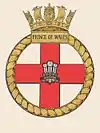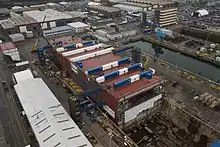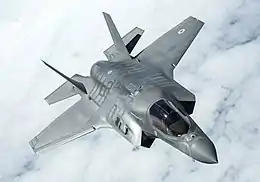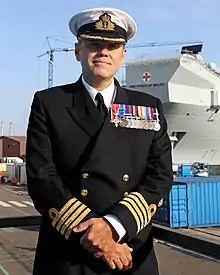HMS Prince of Wales (R09)
HMS Prince of Wales (R09) is the second Queen Elizabeth-class aircraft carrier. Unlike most large aircraft carriers, Prince of Wales is not fitted with catapults and arrestor wires, and is instead designed to operate V/STOL aircraft; the ship is currently planned to carry up to 40 F-35B Lightning II stealth multirole fighters and Merlin helicopters for airborne early warning and anti-submarine warfare, although in surge conditions the class is capable of supporting 70+ F-35B.[12] The design emphasises flexibility, with accommodation for 250 Royal Marines and the ability to support them with attack helicopters and troop transports up to and larger than Chinook size.
_depart_Forth_for_initial_sea_trials_-_19.jpg.webp) HMS Prince of Wales, September 2019 | |
| History | |
|---|---|
| Name: | HMS Prince of Wales |
| Namesake: | The Prince of Wales[1] |
| Operator: | Royal Navy |
| Ordered: | 20 May 2008 |
| Builder: | Aircraft Carrier Alliance |
| Launched: | 21 December 2017 |
| Sponsored by: | The Duchess of Cornwall |
| Christened: | 8 September 2017 |
| Commissioned: | 10 December 2019[2] |
| Homeport: | HMNB Portsmouth |
| Identification: |
|
| Motto: | Ich Dien ("I Serve") |
| Honours and awards: |
|
| Status: | In active service [2] |
| Badge: |
 |
| General characteristics | |
| Class and type: | Queen Elizabeth-class aircraft carrier |
| Displacement: | 65,000 tonnes (64,000 long tons; 72,000 short tons)[4] |
| Length: | 280 m (920 ft)[5] |
| Beam: |
|
| Draught: | 11 metres[6] |
| Decks: |
|
| Speed: | 25 knots (46 km/h) |
| Range: | 10,000 nautical miles (19,000 km) |
| Boats & landing craft carried: |
|
| Capacity: | 1,600 |
| Troops: | 250 |
| Complement: | 679 |
| Sensors and processing systems: |
|
| Armament: |
|
| Aircraft carried: |
|
| Aviation facilities: |
|
The ship was initially planned to be either sold or mothballed due to budget cuts, but the government later decided to bring it into active service. [14] Prince of Wales was formally named in September 2017.[15] Her first seagoing commanding officer was Captain Stephen Moorhouse.[16] As of July 2019, her ship captain is Captain Darren Houston.[17]
The completed Prince of Wales began sea trials in September 2019 and first arrived at her new home base of HMNB Portsmouth in November 2019.[18] The ship was formally commissioned into the Royal Navy at a ceremony in Portsmouth on 10 December 2019.[2] The ship's commissioning date marked the 78th anniversary of the sinking of her predecessor which was lost in action along with HMS Repulse in 1941. She is the eighth Royal Navy ship to have the name HMS Prince of Wales. Construction of the ship began in 2011 at Rosyth Dockyard and ended with launch on 21 December 2017. She was handed over to the Royal Navy in 2019, and will be fully ready for front-line duties around the globe from 2023.[19]
When on operations, Prince of Wales will form a central part of a UK Carrier Strike Group, comprising escorts and support ships, with the aim to facilitate carrier-enabled power projection.[20]
Design and construction


Much like her sister ship Queen Elizabeth, the original 2008 design of Prince of Wales envisaged flying F-35B Lightning II Short Take-Off and Vertical Landing (STOVL) jets from a ski-jump ramp. However, in May 2010, the government published its long-awaited Strategic Defence and Security Review (SDSR), which stated that Prince of Wales would be converted to a Catapult Assisted Take-Off But Arrested Recovery (CATOBAR) configuration, operating the F-35C. An 18-month study commenced into the conversion but ultimately found that it would cause severe cost implications and delays. In May 2012, the government announced it would be reversing its decision to convert Prince of Wales and that the ship would be built to its original STOVL design.[21][22]
The SDSR also stipulated that the UK only required one aircraft carrier, however penalty clauses in the contract meant that cancelling Prince of Wales would be more expensive than building her. Instead, the government planned to construct Prince of Wales and then either place her into extended readiness or have her sold to an ally.[23] Contrary to this, in 2012, the Royal Navy published its annual yearbook, titled A Global Force 2012/13, which stated that both carriers are "likely to be commissioned and may even be capable of operating together".[24]
Prince of Wales was assembled at Rosyth from 52 blocks built by six shipyards around the UK. Construction began on 26 May 2011 with the first steel being cut at Govan shipyard by Defence Secretary Liam Fox.[25] In September 2014, Prince of Wales reached a final assembly phase when hull blocks LB02 and LB03 were floated into 1 Dock of Rosyth dockyard, Scotland.[26]
During the 2014 NATO Summit in Wales, Prime Minister David Cameron announced that Prince of Wales would be brought into active service, rather than sold off or mothballed.[14] This was later confirmed in the government's 2015 Strategic Defence and Security Review.[27]
_at_the_River_Mersey.jpg.webp)
In April 2016, the ship was said to be around 80% structurally complete.[28] On 1 September 2017 HMS Prince of Wales' most senior officer, Captain Ian Groom, confirmed that the carrier was now essential to fulfilling the Royal Navy's 'full carrier strike capability.'[29]
Sea trials
Prince of Wales was formally named on 8 September 2017 at Rosyth dockyard by The Duchess of Rothesay, the wife of the current Prince of Wales. On 21 December 2017, Prince Of Wales was floated out of Rosyth drydock #1 for the first time and manoeuvred to a nearby jetty for fitting-out and further systems integration.[30][15][31] A Merlin Mk2 helicopter landed and took off six times on her flight deck on 23 September 2019.[32] Under current plans, Prince of Wales will start sea trials in 2019 and be commissioned in late 2019[33][31][34] The ship left the fitting out basin at Rosyth for the first time on 20 September 2019; initially she remained anchored in the Firth of Forth, undertaking initial engine and system tests, and waiting for the tide to allow her to pass under the bridges crossing the firth.[35] HMS Prince of Wales sailed under the Firth of Forth bridges on 22 September 2019 and began sea trials.[36]
On 16 November 2019, Prince of Wales arrived at her home base of Portsmouth for the first time, berthing at Princess Royal Jetty.[37]
On 28 February 2020, Prince of Wales arrived in her affiliated city of Liverpool for the first time on a week-long visit.[38]
In May 2020, Prince of Wales experienced flooding which the Royal Navy described as "minor". This was followed by more significant flooding in October 2020 which caused damage to her electrical cabling. She is currently confined to docks where she is expected to remain for at least six months whilst repairs are made. Her long-planned deployment to the United States to undertake her first F-35B trials has been cancelled.[39] During 2020 Prince of Wales had been at sea just 30 days, compared to 115 days for Queen Elizabeth.[40]
Aircraft

The two ships of the Queen Elizabeth class are each expected to be capable of carrying forty aircraft, a maximum of 36 F-35B Lightning II stealth multirole fighters and four Merlin helicopters.[41] The 2010 SDSR anticipated the routine deployment of twelve F-35Bs, but a typical warload will be 24 F-35Bs and some helicopters.[42] These could be a Maritime Force Protection package of nine anti-submarine Merlin HM2 and five Merlin Crowsnest for airborne early warning; alternatively a Littoral Manoeuvre package could include a mix of Royal Navy Commando Helicopter Force Merlin HC4, Wildcat AH1, RAF Chinooks, and Army Air Corps Apaches.[42] As of September 2013 six landing spots are planned, but the deck could be marked out for the operation of ten medium helicopters at once, allowing the lift of a company of 250 troops.[42] The hangars are designed for CH-47 Chinook operations without blade folding and for the V-22 Osprey tiltrotor, whilst the aircraft lifts can accommodate two Chinooks with unfolded blades.[43]
Passenger/crew transfer boats
The two ships of the Queen Elizabeth class will each carry four PTBs made by Blyth-based company Alnmaritec.[44] Each 13.1 m (43 ft) long PTB carries 36 passengers and two crew to operate the vessel and is davit-launched. To enable the craft to fit into the docking area the navigation and radar masts are fitted with Linak actuators so that they can be lowered automatically from the command console. The enclosed cabin is heated and there is a set of heads forward.[45]
Weapons systems
Defensive weapons include the Phalanx Close-In Weapons System for anti-aircraft and anti-missile defence, and 30mm Automated Small Calibre Guns and Miniguns for use against fast attack craft.[7]
Name

The Queen Elizabeth-class carrier is the eighth HMS Prince of Wales, named after the title traditionally granted to the heir apparent of the British monarch. The name was announced at the same time as that of her sister ship Queen Elizabeth.
The decommissioning of HMS Ark Royal under the SDSR in 2010 and led to a campaign for one of the new aircraft carriers to receive that name.[46]
Prince of Wales was formally named on 8 September 2017 at Rosyth Dockyard on the Firth of Forth at Rosyth, Fife, Scotland by the Duchess of Rothesay.[15]
Commanding officers

Battle Honours
Prince of Wales carries the battle honours of her predecessors
- St Lucia 1778
- Ile de Groix 1795
- Dardanelles 1915-16
- Bismarck 1941
- Malta convoys 1941-42[50]
Affiliations
See also
References
- "How did HMS Prince of Wales get her name? Cost, captain, crew size and where Royal Navy aircraft carrier was built". portsmouth.co.uk/news/defence.
- "Commissioning day for HMS Prince of Wales". Royal Navy. Portsmouth. 10 December 2019. Retrieved 10 December 2019.
- The ship carries the battle honours earned by its predecessors. David A Thomas, Battles and Honours of the Royal Navy (Barnsley, S. Yorkshire: Leo Cooper, 1998) Kindle version
- "Queen Elizabeth class". royalnavy.mod.uk. Archived from the original on 7 December 2018. Retrieved 12 January 2018.
- "Queen Elizabeth Class". Royal Navy. Archived from the original on 10 August 2013. Retrieved 21 August 2013.
- "Future Aircraft Carrier (CVF)". Ministry of Defence. Archived from the original on 10 May 2008. Retrieved 21 May 2008.
- "Queen Elizabeth class: facts and figures". Royal Navy. Archived from the original on 27 July 2011. Retrieved 28 July 2011.
- Royal Navy – Global Force 2013 (PDF) (graphic), Press Association, p. 86, archived from the original (PDF) on 21 September 2018 – source: Royal Navy.
- What will the Queen Elizabeth class carriers carry?, UK Defence Journal, archived from the original on 2 February 2017, retrieved 24 January 2017 – source: UK Defence Journal.
- "Replacing the Invincibles: inside the Royal Navy's controversial £6.2 billion warships", Wired, archived from the original on 4 September 2017, retrieved 29 August 2017 – source: Wired UK
- "Fleet Air Arm: future aircraft". Royal Navy. Archived from the original on 2 September 2011. Retrieved 18 September 2011.
- "Replacing the Invincibles: inside the Royal Navy's controversial £6.2 billion warships". Wired. 19 March 2017. Archived from the original on 4 September 2017. Retrieved 29 August 2017.
- "UK aircraft carrier Prince of Wales to go into service". BBC News. 5 September 2014. Archived from the original on 23 September 2014. Retrieved 5 September 2014.
- "Second aircraft carrier HMS Prince of Wales named by Duchess of Rothesay". BBC News. 8 September 2017. Archived from the original on 8 May 2018. Retrieved 21 June 2018.
- "Royal Navy appoints first seagoing Captain for HMS Prince of Wales". Archived from the original on 7 September 2017. Retrieved 7 September 2017.
- "HMS Prince of Wales Commanding Officer". royalnavy.mod.uk. Royal Navy. 4 July 2019. Archived from the original on 25 July 2019. Retrieved 4 July 2019.
Captain Darren Houston
- 16 November 2019 (16 November 2019). "HMS Prince of Wales makes Portsmouth debut". Royal Navy. Retrieved 11 December 2019.
- "Iconic structure is installed on HMS Prince of Wales". Archived from the original on 2 July 2017. Retrieved 14 January 2016.
- "Fleet Solid Support Ships: Procurement". Hansard. Retrieved 5 November 2020.
- "Defence Secretary Announces Decision on Jets for Navy's Future Carriers". royalnavy.mod.uk. Royal Navy. 10 May 2012. Archived from the original on 13 May 2012. Retrieved 10 May 2012.
- "Cats, traps and claptrap. Why the Royal Navy's new aircraft carriers operate VSTOL aircraft". Save the Royal Navy. 19 October 2019. Retrieved 15 December 2020.
- Securing Britain in an Age of Uncertainty: The Strategic Defence and Security Review (PDF), HM Government, October 2010, p. 23, ISBN 9780101794824, archived from the original (PDF) on 22 December 2010
- A Global Force 2012/13 (PDF). Royal Navy. 2013. p. 24. ISBN 978-1-906940-75-1. Archived from the original (PDF) on 21 September 2018.
- "Steel cut on second super-carrier". Navy News.
- http://www.pymes75.plus.com/military/cvf_build.htm
- "National Security Strategy and Strategic Defence and Security Review 2015" (PDF). HM Government. Archived (PDF) from the original on 24 November 2015. Retrieved 20 April 2016.
- "Aircraft Carriers:Written question – 33852". HM Government. 20 April 2016. Archived from the original on 5 May 2016. Retrieved 20 April 2016.
- Ripley, Tim (1 September 2017). "Royal Navy considers two carriers essential for F-35 trials". Janes Defence Weekly. Archived from the original on 5 September 2017. Retrieved 5 September 2017.
- "HMS Prince of Wales floats out". Aircraft Carrier Alliance. 21 December 2017. Archived from the original on 25 December 2017. Retrieved 22 December 2017.
- "Archived copy". Archived from the original on 22 December 2017. Retrieved 21 December 2017.CS1 maint: archived copy as title (link)
- "First aircraft lands on HMS Prince of Wales". Royal Navy. Scotland. 23 September 2019. Retrieved 1 October 2019.
- Maddox, David (23 March 2013). "600 Royal Navy personnel may be stationed at Rosyth". The Scotsman. Archived from the original on 25 March 2013. Retrieved 7 June 2014.
- "Britain's second carrier sets sail for sea trials". UK Ministry of Defence. 19 September 2019. Retrieved 20 September 2019.
- "New aircraft carrier set to make maiden voyage". BBC News. 20 September 2019. Retrieved 20 September 2019.
- Clark, Leeza. "Naval flagship heads under the Forth bridges to start sea trials".
- "HMS Prince of Wales: Navy ship arrives in Portsmouth - BBC News". Bbc.co.uk. Retrieved 11 December 2019.
- "AIRCRAFT CARRIER HMS PRINCE OF WALES ARRIVES IN LIVERPOOL". Royal Navy. 28 February 2020.
- "Royal Navy's new aircraft carrier HMS Prince of Wales stranded in Portsmouth for six months after second flood". The News. 7 December 2020. Retrieved 9 December 2020.
- Hope, Christopher (2 January 2021). "Exclusive: Leaky HMS Prince of Wales spends fewer than 90 days at sea in two years". The Daily Telegraph. Retrieved 3 January 2021.
- Adams, Christopher (25 July 2007). "MoD gives nod for aircraft carriers". Financial Times. Archived from the original on 23 May 2014. Retrieved 19 September 2013.
- Osborne, Anthony (11 September 2013). "U.K. Royal Navy Widening Scope of Carrier Use". Aviation Week. Archived from the original on 16 January 2014. Retrieved 31 July 2019.
- Osborne, Anthony (30 August 2013). "U.K. Builds Fleet of Modernized Chinooks". Aviation Week. Archived from the original on 16 January 2014. Retrieved 31 July 2019.
- "Archived copy". Archived from the original on 15 March 2017. Retrieved 1 May 2017.CS1 maint: archived copy as title (link)
- "Archived copy". Archived from the original on 8 March 2017. Retrieved 1 May 2017.CS1 maint: archived copy as title (link)
- Harding, T (2 May 2011). "Prince Charles 'saves Ark Royal'". The Daily Telegraph. Archived from the original on 5 May 2011. Retrieved 10 May 2011.
- "First Captain joins HMS Prince of Wales". www.royalnavy.mod.uk.
- "First Captain To-Be Of HMS Prince Of Wales Announced". Forces Network. 7 September 2017.
- "HMS Prince of Wales (R09)". www.royalnavy.mod.uk.
- David A Thomas, Battles and Honours of the Royal Navy (Barnsley, S. Yorkshire: Leo Cooper, 1998) Kindle version
External links
- Prince of Wales (royalnavy.mod.uk)